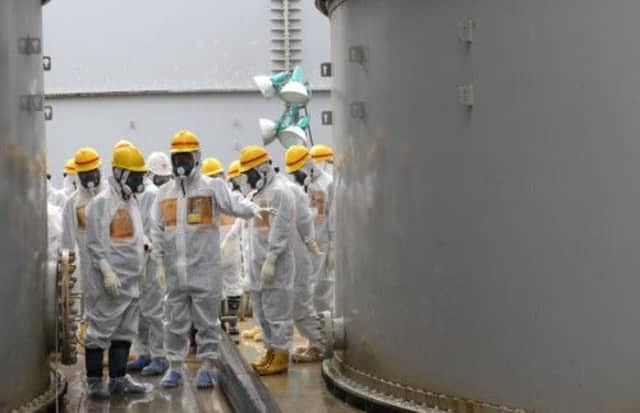Japan: Ice wall plan to curtail radioactive leaks


The decision is widely seen as an attempt to show that the nuclear accident won’t be a safety concern just days before the International Olympic Committee chooses between Tokyo, Istanbul and Madrid as the host of the 2020 Olympic Games.
The Fukushima Dai-ichi plant has been leaking hundreds of tonnes of contaminated underground water into the sea since shortly after the 2011 earthquake and tsunami damaged the complex. Leaks from tanks storing tainted water in recent weeks have heightened the sense of crisis that the plant’s owner, Tokyo Electric Power (Tepco), isn’t able to contain the problem.
Advertisement
Hide AdAdvertisement
Hide AdPrime minister Shinzo Abe yesterday said: “Instead of leaving this up to Tepco, the government will step forward and take charge. The world is watching if we can properly handle the contaminated water, but also the entire decommissioning of the plant.”
The government plans to spend about 47 billion yen (£303 million) through to the end of March 2015 on two projects – 32 billion yen (£206m) on the ice wall and 15 billion yen (£96m) on water treatment units – according to energy agency official Tatsuya Shinkawa.
However, the government is not paying for urgently needed water tanks and other equipment that Tepco is using to stop leaks. Mr Shinkawa said the funding is limited to “technologically challenging projects”, but the government will be open to additional help when needed.
The ice wall would freeze the ground to a depth of up to 100ft through an electrical system of thin pipes carrying a coolant as cold as -40C. That would block contaminated water from escaping the facility’s immediate surroundings, as well as keeping underground water from entering the reactor and turbine buildings, where much of the radioactive water has collected.
The project, which Tepco and the government proposed in May, is being tested for feasibility by a Japanese construction giant Kajima Corporation and is scheduled for completion by March 2015.
Similar methods have been used to block water from parts of tunnels and subways, but building a two-mile wall that surrounds four reactor buildings and their related facilities is unprecedented.
An underground ice wall has been used to isolate radioactive waste at the US Department of Energy’s former site of the Oak Ridge National Laboratory in Tennessee which produced plutonium, but only for six years.
Some experts are still sceptical about the technology and say the running costs would be a huge burden.
Advertisement
Hide AdAdvertisement
Hide AdAtsunao Marui, an underground water expert at Japan’s National Institute of Advanced Industrial Science and Technology, said a frozen wall could be water-tight but is normally intended for use for a couple of years and is not proven for long-term use as is planned in the Tepco outline. The decommissioning process is expected to take about 40 years.
He said: “We still need a few layers of safety backups in case it fails. Plus the frozen wall won’t be ready for another two years, which means contaminated water would continue to leak.”
Mr Marui said additional measures should be taken to stop contaminated water from travelling under the seabed during that time and leaking further out in the sea.
Tepco has been pumping water into the wrecked reactors to keep cool nuclear fuel that melted when the March 2011 earthquake and tsunami knocked out the plant’s power and cooling system. The utility has built more than 1,000 tanks holding 335,000 tonnes of contaminated water at the plant, and the amount grows by 400 tonnes daily. Some tanks have sprung leaks, spilling contaminated water onto the ground.
After spending on the ice wall, the remainder of the public funding will go to the development and production of a water treatment unit that can treat the contaminated water more thoroughly and by a larger volume than an existing machine, which is under repair.
Nuclear Regulation Authority chairman Shunichi Tanaka has repeatedly said that the contaminated water eventually has to be released into the sea after being fully processed and diluted, but only with local consent.